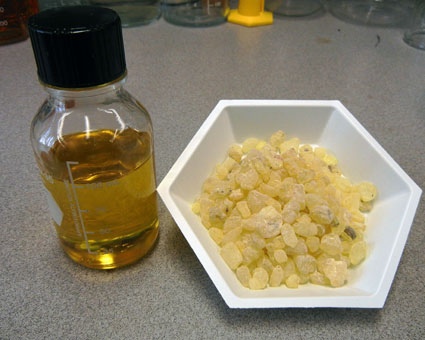Damar balsam mountant
Evaluation of available media
Three permanent mounting media are readily available: Canada Balsam, Piccolyte (e.g. Permount®), and Damar Balsam. Canada balsam has proven unsatisfactory for most gregarine work because it tends to collapse and distort specimens, even when used in a very dilute solution. In addition, available products are highly variable, oten acidic, and with unpredictable polymerization rates and properties. Permount is produces some artifacts but is not stable over the long term and should only be considered a temporary mountant. Damar balsam is by far the superior mountant for gregarine work: it produces artifact-free mounts, does not readily bubble, has archival properties superior to those of Canada Balsam, is of an almost neutral pH, and it is relatively inexpensive. Unfortunately, no ready-to-use preparation of Damar Balsam is currently available although the materials are easily obtained. Preparation of Damar Balsam is outlined below.
Damar gum: evaluating raw resin
Damar Gum is available as a raw resin lumps or "tears" collected from the damar pine along the Pacific Rim and Australia. There are a number of vendors but some care must be given to obtaining and sorting raw resin. Use only light color damar gum. Spectrum Chemical Corp. is an excellent supplier. Dewaxed gum is is available, but is usually dark colored and heat damaged by dewaxing. Dark colored lumps have been exposed to high heat and should be rejected. They are unsuitable for use as mountant.) Raw damar tears are essentially unprocessed and often contain, sand, debris, or even insects (especially ants).
Making damar balsam mountant: the slow method
Choose ca. 25 g of damar tears that a relatively free of dirt and debris. Break up the tears with a mortar and pestle. Place in a sealed jar with 50-75 ml xylene. Agitate daily and allow the damar tears to dissolve, usually about a month. Filter through a double layer of drip coffee filters. Any fine precipitate that forms overnight should be removed by refiltering the mountant. Damar Balsam will thicken if allowed to evaporate and can be thinned with additional xylene. Adjust consistency to your tastes. Specimens cleared in xylene can be mounted directly in Damar Balsam and will harden overnight on a 40 C slide warmer. The mountant, of course, keeps indefinitely.
Making damar balsam mountant: the fast method
Choose ca. 25 g of damar tears that a relatively free of dirt and debris.
Break up the tears with a mortar and pestle. Cautiously heat the gum damar in a beaker over a low heat until it melts. Add to the melted mass approximately 6-8 times it's own volume of xylene and stir to form a uniform solution. Filter through a double layer of drip coffee filters. Any fine precipitate that forms overnight should be removed by refiltering the mountant. Damar Balsam will thicken if allowed to evaporate and can be thinned with additional xylene. Adjust consistency to your tastes. Specimens cleared in xylene can be mounted directly in Damar Balsam and will harden overnight on a 40 C slide warmer. The mountant, of course, keeps indefinitely.
NB:I have had considerable luck in making Damar Balsam with less xylene than is prescribed above. Thus the mountant can be used the next day without waiting for it to thicken. However, heat must be very carefully controlled and the damar must be filtered when hot for this method to bring success.
Using damar balsam
We usually place damar balsam mountant in a 37 C oven overnight before use. The warm damar is considerably thinner than when at room temperature, thus it thickens as it cools, which reduces "edge creep".

